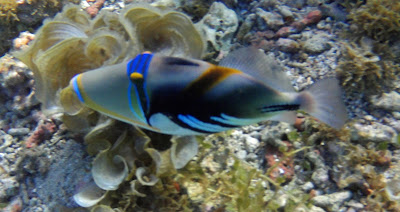I have to admit that I love living on a tropical island. Samoa has plenty of beaches and quite a few clear, cool, rivers with lots of beautiful water falls, which we all enjoy, so we try to spend most every Saturday in the water somewhere. It's been great to see Shanna excited about snorkeling (as long as the water is calm). She and many of the other Sister Missionaries, wear small floatation belts which gives enough buoyancy to feel comfortable. I call it her "feather" because just like Dumbo's feather which gave him the confidence to fly, her "feather" giver her the confidence to swim.
 The islands of Samoa are surrounded with a coral reef that generally limits the depth of water to about 6 feet at high tide and 1 to 4 feet at low tide. Thus tide times become important so you don't get left "high and dry" and have to walk back to the "shore". Within the reef there are quite a few varieties of fish but not many large ones, including sharks, which stay outside the reef. So other than mosquitos there isn't much to be concerned about as far a critters go. The only other sea creature we have been warned about is the Crown of Thorns which is of the Star Fish family.
The islands of Samoa are surrounded with a coral reef that generally limits the depth of water to about 6 feet at high tide and 1 to 4 feet at low tide. Thus tide times become important so you don't get left "high and dry" and have to walk back to the "shore". Within the reef there are quite a few varieties of fish but not many large ones, including sharks, which stay outside the reef. So other than mosquitos there isn't much to be concerned about as far a critters go. The only other sea creature we have been warned about is the Crown of Thorns which is of the Star Fish family.  The crown of thorns has a lot of sharp spines that have a poison on them. We're told if you step on one then you should turn it over and put its mouth on the wound and it will remove the poison. These are not a native species and they eat the coral so we are encouraged to kill them. The problem with killing them is that you can't cut them up or each piece will become a new Crown of Thorns, so you have to impale them on a knife or spear and carry them out of the water.
The crown of thorns has a lot of sharp spines that have a poison on them. We're told if you step on one then you should turn it over and put its mouth on the wound and it will remove the poison. These are not a native species and they eat the coral so we are encouraged to kill them. The problem with killing them is that you can't cut them up or each piece will become a new Crown of Thorns, so you have to impale them on a knife or spear and carry them out of the water.
I don't know what starfish look like in other parts of the world, but here they are blue. At first glance they look like a discarded blue rubber glove.
I saw a fish that changed its color and patterns as it moved back under some coral which made it very hard to see when it stopped moving. The photo below is also a "camo" fish but it doesn't change. I think it resembles a lot of clothing I've seen my family wear.
 At Puolou Deep we see large schools of bright blue fish that are generally swimming quite close to the surface. Depending on the location of the sun, their color changes from the blue to a fluorescent yellow green.
At Puolou Deep we see large schools of bright blue fish that are generally swimming quite close to the surface. Depending on the location of the sun, their color changes from the blue to a fluorescent yellow green.  This yellow fish has a body shape that,from the front, is almost square. He reminds me of an over ripe banana.
This yellow fish has a body shape that,from the front, is almost square. He reminds me of an over ripe banana. I think I may have include the clams on other blogs, but they are so spectacular that they need to be included again. These two are baby ones that are about 18 inches in length.
I think I may have include the clams on other blogs, but they are so spectacular that they need to be included again. These two are baby ones that are about 18 inches in length. 













